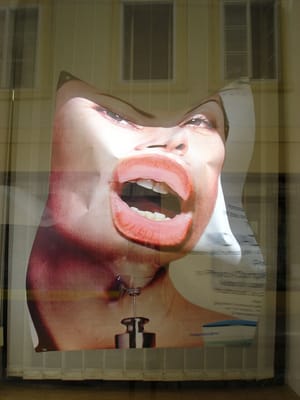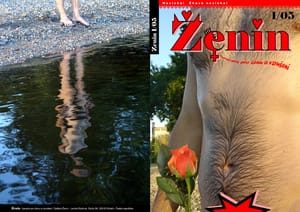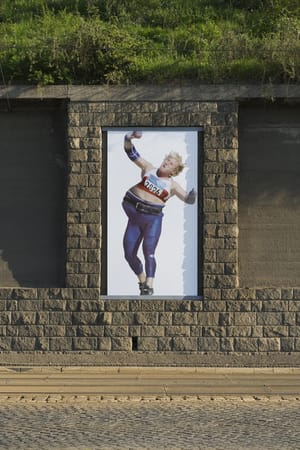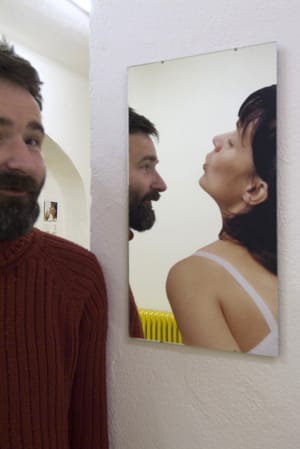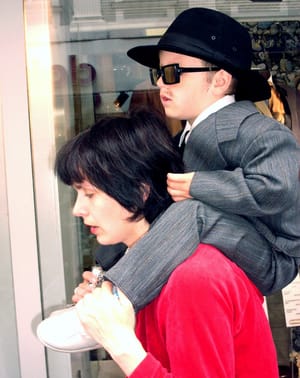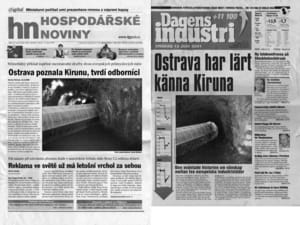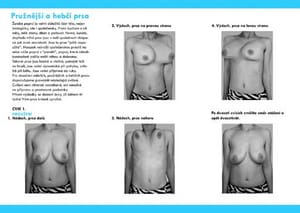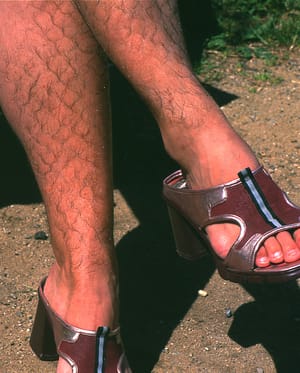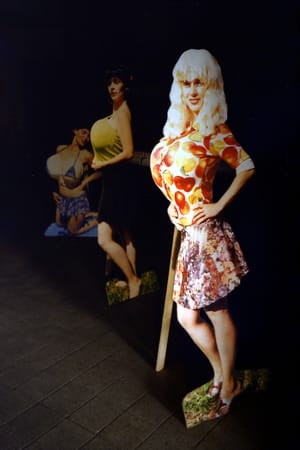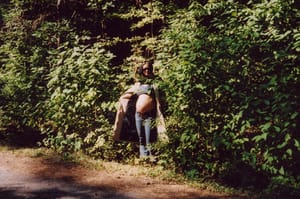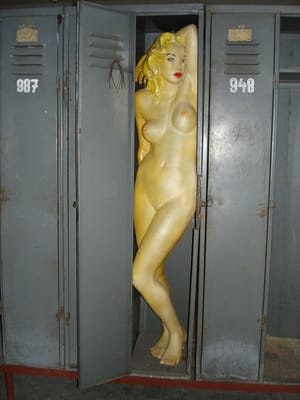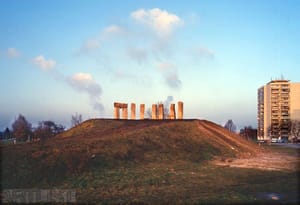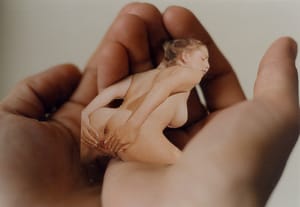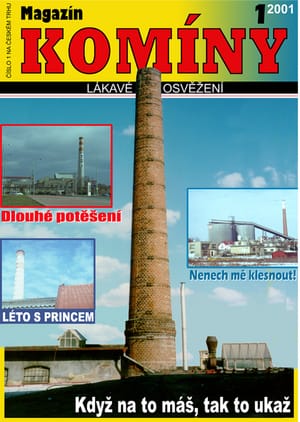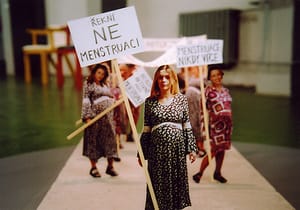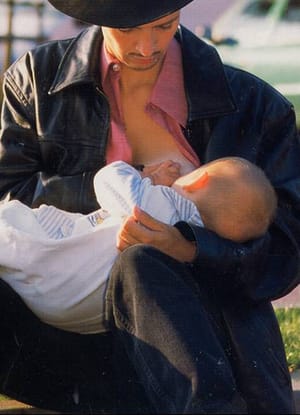- First Name
- Lenka
- Surname
- Klodová
- Born
- 1969
- Birth place
- Opava
- Place of work
- Prague
- i-datum
- ↳ Find in the VVP AVU database
- Keywords
- CSU Library
- ↳ Find in the catalogue
About artist
Lenka Klodová is a visual artist, performer, sculptor and teacher who has been active on the Czech art scene since the 1990s. The central motif of her work is the human body, which she perceives within an extended field and via multi-layered contexts moving beyond its physical boundaries into the social and political sphere. She works with the themes of intimacy, sexuality, motherhood and interpersonal relationships. She focuses on social constructs and stereotypes, which she reflects upon from a gender-based perspective, and explores the dynamics, conduct, and situations that ensue from given social structures. Her work is often of an ambivalent and subversive character, highlighting the complexity and ambiguity of established categories, opinions and beliefs.
Klodová first came into contact with art during the 1980s thanks to the unofficial Ostrava scene. From 1987 to 1990 she studied at the Faculty of Education in Ostrava, where she met Jiří Surůvka, thanks to whom she began to take an interest in the action and conceptual art of that time. An important event was the one-day collective exhibition Ahoj lidi / Hi People (1989) in the subway of the Ostrava bus station organised by Surůvka, Petr Lysáček and František Kowolowski, as well as the founding of the group Přirození (1988), which along with the artists mentioned above included Daniel Balabán, Pavel Šmíd and Hana Puchová. This free association of writers and artists was characterised by its fondness for humour, irony and the ridiculous, with a critical undertone. Many members of the group were drawn to action art and performance and worked with social questions and everyday situations, which they then subversively refashioned, shifting their meanings into unexpected contexts. This approach, as well as the individual events as such, provided Klodová with the motivation and inspiration for her own artistic projects.
Klodová joined the Academy of Arts, Architecture and Design in Prague in 1990 and studied at the sculpture studio headed by Kurt Gebauer (active between 1991–1997). From the very start she eschewed a focus on purely classical sculpture. This was influenced both by the overall atmosphere of the studio, with many classmates searching for ways of overcoming the traditional boundaries of genre and form, as well as her personal situation at that time: she joined UMPRUM after having her first child. Her works from that period also show the clear sign of her experience with the Ostrava art scene, which culminated in multivalent works with a humorous and subversive subtext. An example would be Záhonky (1994) installed at the Botanical Gardens in Troja, Prague. The artist spread several items of women’s clothing with a floral design on the grass and covered the edges with pieces of bark, thus turning them into part of nature. She underlines the ambiguity of the symbols with her own and other women’s names also representing flowers (Jiřina / Dahlia, Květa / Blossom and Růžena / Rose). The artist’s game with language, meaning and metaphor does not obscure the ironic character.
The installation Sen / Dream (1994) from Klodová’s first exhibition in the Municipal House in Proseč has a poetic, lyrical quality. Thanks to the lighting, a seemingly homogenous pile of hay in the corner of the room reveals, upon closer inspection, silhouettes that can be read as a reference to or a fragment of a letter. In this work light functions in relation to meaning as an ambivalent element, revealing, obscuring, connecting and separating. It encourages different modes of reading and it makes visible and visualises the fluctuation between different meanings. Klodová continued to explore this aspect in several subsequent projects. In the Fiducia Gallery in Ostrava, for instance, she created the light installation Červená a černá / Red and Black (1998). The installation consisted of illuminated, red-painted letters that cast a shadow on the back wall, in the middle of which, however, there was a black smudge covering the syllable “ve” and transforming the original word červená [red] into černá [black]. The moment of transformation reveals that black is always concealed within the word red. By making this fact visible on a conceptual and visual level, the word červená is transformed and expanded. With this simple gesture involving two everyday words, the artist was able to create a multi-layered narrative that requires both imagination on the part of the viewer as well as the work of the gaze itself and its ability to decode the visual reference.
We find a similar principle at work in the most famous piece by Klodová from this period, which formed part of her dissertation and was titled Božena (1997). The work consisted of six monumental letters made of any materials to hand, such as plywood or plexiglass, with light bulbs fitted inside, that could be switched on or off at various intervals thus creating different constellations of meaning from the individual letters. The name Božena itself is an important starting point for the entire project. Firstly, it is the name of Klodová’s daughter, who was born during the artist’s studies. However, the work also refers to the artist’s famous namesake Božena Němcová and her legacy, and to the various traditions associated with the name Božena. By switching on and off lights, this name, already filled with meanings as a whole, breaks down into fragments that point to its other content, e.g. ŽENA and BOŽE – ŽENA. Thanks to these “hidden” words this name-word acquires a new meaning, a sacral and primordial character, which can refer to the originary femininity and divinity contained within it. In addition, the power of the work resides in the fact that the act of illumination is not synonymous with explanation and thus retains its inherent ambivalence.
After graduating from university, during her maternity leave Klodová focused on cutting, gluing and creating collages from pornographic magazines. This became an important springboard for her work in the following years, characterised by her interest in the female body, sexuality, but also sexualisation and objectification. In early collages such as Spáčky / Sleeping Women (1999), the artist approaches the body as an open structure and explores its nature, character and significance under changing circumstances. Her approach avoids moralising, but emphases the act of caring, as when she gently dresses cut-out models in duvets or clothes (Lidovky / People, 2001 and Panenky / Dolls, 2001). All of these activities take place in the artist’s home, and the cut-out characters are perceived as dolls rather than sex bombs. In this way, the sexualised bodies of the models, who were originally to be the object of pleasure and excitement, become caricatures, their expressive faces or positions become incomprehensible, unable to fulfil their original function, and thus they reveal their genuine character to be performative in nature. Klodlová deploys this strategy to highlight the alienation of women both from the descriptive way of representing the female body and sexuality and the models from themselves. She attempts to return identity to anonymous models, to incarnate them, to “return” their genuine physicality to them. This tension between the two-dimensionality of pornographic dolls and the real body is explicitly reflected in Klodová’s photographic project V rukou / In Hand (2001). In this work the artist gently takes the female figures in the picture into her hands, offers them maternal protection, and at the same time makes visible and subverts the tension between the human body and the image as used in a pornographic magazine.
In addition to the physical aspect, Klodová complicates the theme of female sexuality and its forms. For example, in Rodička (2002) she interrogates the constructed polarity of the sexual and pregnant female body. The way in which these two physical forms are represented in Western culture is usually based on the antithesis of sensuality and temptation on the one hand, and chastity and the sacralisation of motherhood on the other. However, in Rodička / Expectant Mother, on the basis of a simple mechanism by which the viewer can transform the model into a woman in labour, she questions this duality, breaks the clear line between two stereotypical identities, and obscures how the female body is perceived and what is expected of it.
The issue of the pregnant body became more and more important in Klodová’s work. The event entitled Bojíte se mateřství? / Are You Afraid of Motherhood? (2003) in the Lapák woods in Kladno is based on the confrontation of random passersby with the bulging belly of a pregnant woman concealed in the forest thicket. The exposure of people to an unwanted view of a naked, pregnant belly, which is suddenly revealed from beneath a long coat, or to be more precise, the negative reactions of most onlookers, illustrates the taboo nature of this physical form. The attempt to ignore and suppress the view of the pregnant body reaches deeper, pointing to a deeper social idea of motherhood and the nature thereof. In the photo installation Řekni ne menstruaci! / Say No to Menstruation! (2004) Klodová continues her social reflection on motherhood by means of a group of pregnant women demonstrating for an increase in the birth rate. The basis of this protest is the rejection of menstruation, by which the artist points to the ambivalence of this biological phenomenon as both a thwarted chance and a moment of emancipation. At the same time, however, she complicates the stereotypical view of pregnancy as a period of passivity by depicting heavily pregnant women as protesting activists. Another project entitled Vítězky / Winners (2005), for the Artwall Gallery in Prague, is in a similar vein. It comprises digitally edited photographs of top female athletes achieving record performances while in the last trimester of pregnancy. The unusual image, which seemingly combines two unlikely events, points to how limited the depiction of pregnancy is in society, and to the perception of female self-realisation as such. In all of her works from the early 2000s the artist continues to deploy strategies involving the problematisation of meaning, ambiguity and subversion, which are based on the disruption of the stability of given signs and symbols.
From 2000 onwards, Klodová began to produce her own pornographic pseudo-magazines. The basic concept involves using an ambiguous element that, within a certain context, might resemble the female and male sexual organs or sexual positions. These magazines are based on absurdity and humour. In the first issue, entitled Bříza / Birch (2000), Klodová collected photographs of the trunks and branches of birches, which she dressed in skirts and thus invested with an almost erotic charge. In the issue entitled Komíny / Chimneys (2001) she again focused on industrial chimney stacks, emphasising their phallic shape as well as their ubiquity in industrialised landscapes. An important element of both issues was the manipulation of photographs so as to underline their sexualised character, as well as the use of text limited to double-edged slogans and phrases.
Both issues of the magazine are focused on desire, objectification, as well as on the very view that seeks out, recognises and observes this object of desire. The way that in this situation an anthropomorphised inanimate object becomes such an object of desire, means the gaze, expectations and imagination of the artist and the viewer are rendered visible. Klodová further developed the theme of the gaze, desire and imagination in Šatna / Changing Room (2002). This work consists of a life-size female figure inserted in one of the worker’s lockers in the Mayrau Mining Museum in Kladno. This three-dimensional female figure responds to the decoration of several of the adjacent workers’ lockers, which are adorned with pictures of half-naked women from various magazines. The seductive female figure represents the materialisation of the desire emanating from the male gaze and its imagination. An ironic subtext of this work is the fact that the sexual idea fills the entire locker, leaving no space for tools. The following year the artist continued this train of thought in another mining museum, this one in Landek, Ostrava. She installed stands with life-size photographs in which she poses with workers’ helmets instead of breast implants, thus completing the appeal of her figure (Dolly Buster, 2003).
Desire and its imaginaries are themes that are also present in Klodová’s earlier work Miluji / I Love (2001) in Neratovice. This is a monumental landscape intervention consisting of six three-metre letters created from hand-worked sandstone blocks and placed on a six-metre high mound. The letters spell out “Miluji” (I Love), and can act as a reference, belief, monument or place of pilgrimage. In terms of its materials and composition this project evokes a sacral and mysterious impression reminiscent of Klodová’ early work Božena. The connection to this work is reinforced by the starting point, a quote from the writer in question, Božena Němcová. However, the brevity of this statement underlines its universal character. The construction of this monumental sculpture was accompanied by photo documentation of a performance given by Klodová with Lucie Jandová and Helena Poláková, which was published in a magazine under the title Krásné holky v akci / Beautiful Girls in Action (2001– 2003). This series of photos depicts the artists working fictitiously on the monument in clothes suggesting that they are sex workers. The very positions they adopt while working are intended to illustrate and promote their erotic services. The project has a fundamentally critical and ironic dimension, the aim of which is to interrogate and in part disparage the artist’s own work and disrupt its serious and lyrical atmosphere, as well as the seriousness of the artist herself, a trait that is often to be found across the spectrum of Klodová’s work.
All the works mentioned so far fed into the following key work ‒ Ženin / Women’s (2002–2005). Ženin is a pornographic magazine for women that was the outcome of several years of research by the artist as part of her doctoral thesis. She drew on her knowledge of the visual language of pornographic magazines and an analysis of female sexuality and desire, and underpinned her project with a survey of women that dealt with topics such as: self-interest, a woman in the centre of attention, woman perceived as more than merely gender, strategies to provoke excitement and desire, touching, emotions or memories. One of the main benefits of this survey was the finding that most of the women interviewed expected a story from a pornographic magazine. Klodová created the entire narrative of her magazine on this premise and used the concept of time as one of the important tools with which she aimed to place control in the hands of the reader, for instance, by turning the pages and setting the rhythm of the unfolding story. Another innovation of the magazine Ženin was the way it expanded the story over several weeks, which meant it was not restricted merely to the repetitive sexual act like traditional pornography. Klodová depicts sexuality within a broader context. She also focuses on intimacy and everyday life in the home. Her concept shifts from sex and eroticism to the study and depiction of interpersonal relationships in which sex is merely one of the many components in a mutual relationship with other aspects of a partnership. Klodová intensifies this approach visually, as the photograph is supplemented by motifs of lace and other folk attributes, or by other soothing and homely images. The sexual act is then depicted in a way that fundamentally deviates from common standards. It is portrayed as if it was taking place right in front of the reader’s eyes, who now identifies with the actress herself. This again opens up themes of the gaze and the attempt to bridge distance rather than alienate via pornographic material. However, this bridging of distances obscures the depiction of sex. We see only hints, a glimpse of hand or knee, since the woman being made love to is also the photographer, and the reader is thus an active part of authentically depicted intercourse. The final output of Klodová’s doctoral research, the pornographic magazine for women Ženin, was exhibited at the Gallery of the Academy of Arts, Architecture and Design in Prague along with the text Zásadami pro vytvoření pornografického časopisu pro ženy / Principles for the Creation of a Pornographic Magazine for Women, which contained the basic rules for publishers of pornographic magazines wishing to meet the demands of a female public.
The project Ženin (2002–2005), in addition to its other features, is remarkable for the way it explores partnerships and family life. Klodová has long dealt with relationships, their forms and changes. In her performance work Travestishow (2001) she looked at the combination of the female and male element in a single person. Dressed in male clothing she underlines this performance of masculinity by opting for a stereotypically macho character. Dressed as Desperado she pushes a pram while breastfeeding her baby, complicating and undermining the traditional male form, dissolving the boundary between female and male identity and the performance thereof, and problematising the traditional gender roles of the family. She also examines the relationships and family life collectively as a member of the group Matky a otcové / Mothers and Fathers, which she co-founded in 2001. Along with Martin Péč, Marek Rejent and Lucie Krejčová, Klodová shares non-artistic, family sorrows, which she subsequently transformed into joint art projects. At the same time she did not avert her gaze from the often-hidden topic of sexuality and the family, since, as she says herself, without sex and intimacy, the family would not exist. She emphasises this point in the conclusion of the magazine Ženin in a passage entitled “how we started”, as well as in the later work Opravdu / Really (2007), in which she takes photographs of children and replaces their eyes, more specifically the lenses, with illuminated miniature photographs of their parents during intercourse. These intimate moments, which the viewer sees instead of the child’s gaze, represent memories stored in the unconscious indicating the moment of bodily contact in which a new life is born. Between 2008 and 2010 the artist created several works based on the principle of structure (Alternativní struktura / Alternative Structure, 2008–2009 and Trojúhelníková struktura / Triangular Structure, 2010), which reflect on the new life situation of imminent middle age and the resulting changes in the functioning of the family. These structures are based on photographs of couples and their families converted into spatial elements forming a three-dimensional construction in space. They reveal the invisible social structures of relationships, their support, fragility and strength.
Around 2004, Klodová began to focus more systematically on topics related to middle age, the transformation of the female body, and the standards of female beauty. Projects include a series of exercises aimed at encouraging more flexible and smoother breasts entitled Brožura / Brochure (2003), in which the artist plays humorously with the digital manipulation of a photograph of her own chest and designs a series of regular exercises aimed at maintaining the youthfulness and firmness of a woman’s breasts. In Mé punčochy / My Stockings (2003), Klodová invents an aesthetic treatment of the hair on legs using hairspray that would be an alternative to shaving, a practice usually required of women. In Venuše Polabská (2004) she interrogates the idea female figure and its unattainable form and makes fun of it by dressing in inflatable flesh-coloured wheels, thus taking on the form of ancient femininity we see in the well known Venus of Dolní Věstonice. In this form she sunbathes on the bank of the River Vltava and swims in the river, all the while documenting her activities in photographs. In another photographic work entitled Pojmenuj mě nově / Name Me Anew (2008) she explores the female body in various everyday situations but without head, neck and hands. In this form it is defined by the external view, restricted not as a living body, but as an object. This is indicated by the title, which calls on the viewer to subject the posing body to their imagination and imprint on it their own concept, a new identity.
In 2007 Klodová took up a teaching post. To begin with, along with Vlasta Čiháková-Noshiro she lectured in the Philosophy of Postmodernism and Gender at the Faculty of Fine Arts of the Brno University of Technology. The course was taught at the Body Design Studio headed at that time by Jana Preková. A year later Preková invited Klodová to teach her own porn studies course at the studio as an offshoot of her doctoral project. Klodová examined the ways of depicting the human body, sexuality and interpersonal relationships, while taking account of the context of eroticism from the perspective of art history and the very topic of nudity in art.
In 2010 Klodová replaced Jana Preková as head of the Body Design Studio. When putting together a course at the studio, Klodová focused on interdisciplinarity and the overlaps between art, the humanities and the natural sciences. She focused on a social reflection viewed through the human body as the primary starting point. Within the context of the studio, she also outlined the form of a possible new discipline called Androgynecology, the study of humankind by humankind. This project was based on a two-semester studio project undertaken in 2010–2011, which aimed to explore work with a female and male model and analyse the dynamic in which a dressed body clashes with a naked one. The project was historically anchored and reflected on an established phenomenon in the sphere of art. However, thanks to cooperation with the men’s magazine Maxim there was also a media overlap and finally a sociological survey of interpersonal relationships between female students and male models.
Several years working as a lecturer enabled Kloková to reflect more deeply on her own artistic work and pedagogical leadership, and this culminated in the publication of Nahé situace / Naked Situations (2016). In this book Klodová describes what she means by naked situations within the framework of her own creative work and teaching. These are situations including elements of the body, interaction, specificity and place. Naked situations trigger a flow of meanings, connections, relationships and connotations with a social and political overlap. They are inherently ambivalent, because they are based on the duality of the artist’s own naked body and another’s body, they are always circumscribed and defined by their context, and from this thought arises the idea of the word “situation”, which refers to the situationism of nudity within a complex network of relationships.
Lenka Klodová is the founder and curator of the Festival of Naked Forms, which took place for the first time in 2015 in the premises of a former paper mill in Vrané nad Vltavou. The aim of the festival was to encourage a reflection upon naked situations in the sphere of Czech performance. In addition, since 1998 Klodová has been involved in designing children’s playgrounds, and since 2005 has been collaborating with the Strašné dítě / Enfant terrible brand. Projects include the Rex playground at the Prague ZOO (2009) and the playgrounds in the Mayrau u Kladna (2010) and Landek v Ostravě (2009) museums of mining.
- Author of the annotation
- Viktória Beličáková
- Published
- 2020
Lenka Klodová’s works centre primarily on the female being, embodiment, sexuality and motherhood. She completed her studies at the Art-Industrial College (VŠUP) by creating a momentous statue called Božena, which foreshadowed the artist’s interest in the female experience and indicated her conceptual approach to this theme and her sense of humour.
Many of Lenka Klodová’s works are inspired by her own maternal experience (Golden Children / Zlaté děti, Drag Show / Travestishow, The Couple / Pár). However, she never did this in a truly autobiographical sense (Who’s afraid of motherhood? Kdo se bojí mateřství?, Mini-Parent /Rodička, Say No to Menstruation / Řekni ne menstruaci, A Time for Woman / Čas ženy). Ms. Klodová also did not forget other basic social themes related to the female body, whether they concerned dictates on female beauty (I / Já, My Stockings / Mé punčochy, Labe Area Venus / Polabská Venuše, Dolly Buster), the unrealistic aspects of female roles (Life with a Handicap / Život s handicapem), use of the female body in advertising (To Kiss / Libát) or the pornography industry (Virgins / Panny, An Autumn Night is Long in Name Only / Podzimní noc je dlouhá jen svým jménem, In Hand / V rukou, Isles of Desire / Ostrovy touhy, Folk Tunes / Lidovky, Scenes / Scény). A question to which Klodová continually returns is expression of female erotic desires and the relationship between man and woman (You, Female / Ty, Ženin, I love / Miluji).
- Author of the annotation
- Zuzana Štefková
- Published
- 2006
CV
Studies:
2002-2005 PhD studies at the Academy of Applied Arts, Architecture and Design
1990-1997 Academy of Applied Arts, Architecture and Design (ateliér designu prof. O. Diblíka, ateliér sochařství prof. K.Gebauera)
Employment:
since 2000 assistant in the studio of sculpture, Academy of Applied Arts, Architecture and Design Prague
Stipends:
1994 Escola de las Belas Artes, Lisabon, Portugal
1992 Staffordshire Polytechnic, UK
2002 - finalist of Jindřich Chalupecký Award
- Member of art groups included in ARTLIST.
- Member of art groups not included in ARTLIST.
- Matky a otcové (Mothers and Fathers) since 2001
Exhibitions
- Solo exhibitions
-
2013
Lenka Klodová: Abeceda, etc. galerie, Praha 2
2013
Lenka Klodová: Figurativní tvorba, Galerie výtvarného umění v Chebu, Malá galerie, Cheb
2011
Lenka Klodová: Sociální potvora, Karlin Studios, Praha
Lenka Klodová: Příběhy žen, Galerie Kaple, Valašské Meziříčí (Vsetín)
2009
Lenka Klodová: Struktura, 2008, Pražákův palác, Brno
2008
Lenka Klodová: Pojmenuj mě nově / Name Me Anew, hunt kastner artworks, Praha
2006
Libát. Galerie DoOka, Praha
2005
Ženin 1/05, Galerie VŠUP, Praha
Vítězky, Art Wall Galerie, Praha
O_šetření, Důl Michal, Ostrava /s P.F.Čiernou/
Něžné připomínky, Povážská galerie Žilina, Slovensko /s P.F.Čiernou/
Helden, Ikonen und Damonen, PGAL, Berlín /s A.Wagnerem a D. Hotzem/
Dvi lijki, Galerie RA, Kyjev, Ukrajina /s J.Surůvkou/
2004
Ty, Galerie Erasmus, Mělník
Exhibition, Galerie 99, Dům umění města Brna, Brno
2003
66.6% ženskosti, Galerie města Plzně /s K.Gebauerem a I.Junkovou/
2002
Lesem za nocí, Galerie 761, Ostrava
2001
Podzimní noc je dlouhá jen svým jménem, Galerie Malá Špálovka, Praha
Moje ženy, Galerie Pokorný, Prostějov
1999
Hlasy přátel, Galerie Jáma 10, Ostrava
1998
Červená a černá, Galerie Fiducia, Ostrava /spolu s M.Rejentem/
1997
Kámen, žena, elektřina, Galerie Die aktualitat des Schone..., Liberec /spolu s M.Rejentem/
1996
Jízda, Makromolekulární ústav, Praha
1994
Obecní domek, Proseč /spolu s M.Rejentem/
- Group exhibitions not included in ARTLIST.
-
2013
Vnitřní okruh v současné české fotografii, Městská knihovna, 2. patro, Praha
2012
Lenka Klodová, Barbora Trnková: Ranní setkání, Dům umění města Opavy, Opava
2011
Výstava veškerého sochařství / Exhibition of All Sculpture, Galerie Havelka, Praha (Prague)
Transgender Me, Galerie NoD, Praha
Velocypedia, Galerie Národní technické knihovny (Galerie NTK), Praha
2010
Sex extrémně líbezný, Galerie XXL, Louny
Absurdita? Groteska? Ironie?, Galerie NoD, Praha
Fenomén hra, Galerie Národní technické knihovny (Galerie NTK), Praha
Limity těla / Body Limits, Galerie Národní technické knihovny (Galerie NTK), Praha
2009
Po sametu / After Velvet. Současné české umění s přesahy do minulosti / Contemporary Czech Art with Past Connotations, Dům U Zlatého prstenu, Praha
Ostrava?, Výstaviště Černá louka, Pavilon A, Ostrava
Something of Myself: 23 autoportrétů / 23 self-portraits, hunt kastner artworks, Praha
Velmi křehké vztahy, Galerie Armaturka, Ústí nad Labem
2008
Sexismus?, Galerie Václava Špály, Praha
2007
Cooking Art aneb Smažíme umění, Galerie kritiků, Praha
Umění porodit, Veletržní palác, Praha
BETON: Výstava objektů a fotografií, Městské muzeum a galerie, Břeclav
2006
Umění porodit, letohrádek Portheimka, Praha
Stop násilí na ženách, galerie 2C2, Praha
Shadows of Humor, BWA Gallery, Wroclaw, Polsko
Amor vincit omnia, Saarländische Galerie – Europäisches Kunstforum e.V., Berlín (Berlin)
2005
Beauty Free Shop, Praha
Ženy mezi horníky, Skanzen Mayrau, Kladno
IBCA, Národní galerie, Palác Kinských, Praha
Insiders, Galerie Futura, Praha
2004
Tento měsíc menstruuji, Galerie Art Factory, Praha
Pure Beauty, Galerie kritiků, Praha
Nová místa, projekty pro sympozium, Dům umění, Opava
Insiders, Galerie města Brna, Dům pánů z Kunštátu
Eintritt Verboten, sympozium, důl Michal, Ostrava
Eastern Aliance, Lichtturm, Berlin
KunstLandSchaf/f/t, Factory, KunstHalle Krems, Rakousko
Eros, Galerie české plastiky, Praha
Czech-In, Stadtwerkstatt, Linz, Rakousko
2003
Wunderland, česko-švédské sympozium, Kiruna, Švédsko
Wunderland II., Ostrava, Hornické muzeum Landek
Waiting for event…, Galerie&Projekte Matias Kampl. Berlin
Valenčné sféry, Pálfyho palác, Bratislava, Slovensko
Umělci v lese, les Lapák, Kladno
ArtCubicle, galerie Home, Praha
Art Actuell, Galerie&Projekte Matias Kampl, Berlin, Německo
INOUT, festival digitálního obrazu, Praha
Art on Street, Praha-Karlín
5 žen, 5 otázek, Galerie Jelení, Praha
2002
Zvon 2002, bienále mladého umění, Dům U kamenného zvonu, Praha
Sochaři na Mayrau, sympozium, Vinařice u Kladna
A sakra!, Galerie 1, VŠUP Praha
Finále, výstava finalistů Chalupeckého ceny, Dům umění, Brno
2001
Slepená intimita, Galerie Jelení, Praha
Open house, rezidenční pobyt, Čimelice
Má vlast, výstavní síň VŠUP Praha
Fotok, Budapešť, Maďarsko
Femme fatale, Galerie Felixe Jeneweina, Kutná Hora
2000 - Open Air, putovní galerie Exodus, Vodičkova ul., Praha
Jižní záležitost, galerie Nová 1, České Budějovice
1998 - Dole v Bunkru, prostor bývalého rockového klubu, Praha
Ateliér veškerého sochařství, Richterova vila
1997
Oživené město Neratovice, Společenský dům, Neratovice
1996
Letos, výběr klauzurních prací, výstavní síň VŠUP, Praha
1995
Andere Orte, německo-český sochařský projekt, Wuppertal, Německo
1994
Vítání jara v Botanické zahradě, akce s výstavou studentů soch., Botanická zahrada, Praha – Trója
Kvanta 272/14, českoněmecký sochařský projekt, ul. Na bělidle, Praha – Smíchov
Junge Kunstler aus Prag, výstava VŠUP a AVU, Kunstmuseum Ehrenhof, Dusseldorf, Německo
1993
Kabrňáci z Prahy, studenti at. soch., Galerie Stará radnice, Dům umění města Brna, Brno
1992
VŠUP Dnes, Sýpka u Vlkova
Objekty a instalace, práce studentů VŠUP, ateliéru sochařství, Karolinum, Praha
- Other realisations
Symposiums:
2004
Sochařské sympozium Opava 2004, Nová místa, Dům umění města Opavy, Opava
Monography
- Monography
Katalogy
MORGANOVÁ, Pavlína, ed. Někdy v sukni: umění 90. let. Vyd. 1. Brno: Moravská galerie v Brně, 2014.
PACHMANOVÁ, Martina, ed. et al. Behind the velvet curtain: seven women artists from the Czech Republic: Erika Bornová, Milena Dopitová, Lenka Klodová, Zdena Kolečková, Alena Kotzmannová, Michaela Thelenová, Kateřina Vincourová: [American University Museum at the Katzen Arts Center, Washington, D.C., April 3 - May 18, 2009. 1st ed. In Prague: Academy of Arts, Architecture and Design
KLODOVÁ, Lenka. Klodová: pregnant songs. Praha: Divus, [2005].
Publikace
KLODOVÁ, Lenka. Nahé situace. Brno: FaVU, 2016.
KLODOVÁ, Lenka et al. Prostorový akt: jevy a tělesnost v prostoru jako pojítko mezi umělci a architekty. Překlad Scott Andrews. Vydání první. Brno: Fakulta výtvarných umění Vysokého učení technického v Brně, 2015.
- Personal texts not included in database
Lenka Klodová, Viktor Špaček: Mám rád věci, ty mlčenlivé soudruhy, Umělec 2005/3
http://divus.cc/london/cs/article/viktor-spacek-i-like-things-those-quiet-comradesLenka Klodová, Správně tmavá na lásku, Umělec 2005/1
http://divus.cc/london/cs/article/all-dolled-upLenka Klodová, Autenticky žitý stereotyp _ opomíjený fenomén manželského umění, Umělec 2005/1
http://divus.cc/london/cs/article/authentically-lived-stereotypes-the-hidden-phenomenon-of-marriage-artLenka Klodová, Kampaň na těle a v těle, Umělec 2005/1
http://divus.cc/london/cs/article/a-tale-of-two-t-shirtsLenka Klodová, Jiřího Košile, Umělec 2005/1
http://divus.cc/london/cs/article/jiri-s-shirtLenka Klodová, Piva Harley a Aurora Davidson, Umělec 2005/1
http://divus.cc/london/cs/article/piva-harley-and-aurora-davidson-1994-96Lenka Klodová, Jak maluje pravá zpěvačka?, Umělec 2005/1
http://divus.cc/london/cs/article/how-a-natural-born-singer-paints

